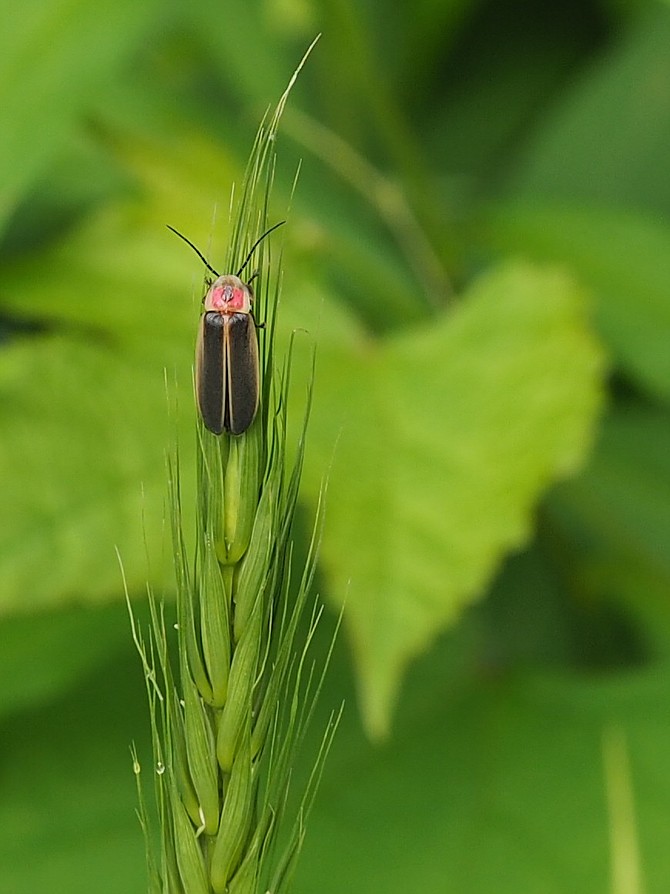Warm summer night skies often sparkle as fireflies flash and twinkle across the firmament. Called lightning bugs by many people, fireflies, are actually winged beetles. They have an organ in their abdomen that lights up, a process called bioluminescence. There are over 2,000 firefly species in the world, 170 in North America.
Why do they flash their light? According to Marc Branham in a Scientific American article, they may be signaling that they are unpalatable to predators and some are sending mating signals. He wrote, “Several studies have shown that female fireflies choose mates depending upon specific male flash pattern characteristics. Higher male flash rates, as well as increased flash intensity, have been shown to be more attractive to females in two different firefly species.”
In another article, Branham wrote, “each species of bioluminescent adult firefly has its own flash fingerprint. Males fly through the air and search for females with a species-specific light display. Some flash only once. Some emit ‘flash trains’ of up to nine carefully timed pulses. Others fly in specific aerial patterns, briefly dipping before sharply ascending and forming a ‘J’ of light. A few even shake their abdomens from side to side and appear to be twinkling.”
Virginia’s state arboretum, Blandy Experimental Farm in Boyce, near Winchester, has one of the largest concentrations of fireflies in the state, a natural summer light show of hundreds of thousands points of light as the insects flicker through the fields and forests. “This is firefly heaven. I’ve never seen anything like it,” noted Dr. Kyle J. Haynes, a University of Virginia insect population ecologist.
Like many of the world’s insects, fireflies are in serious decline. Experts offer multiple reasons, including pesticides, habitat loss and degradation and light pollution.
Before the mid-1800s, most people and wildlife lived under night skies lit only by the moon and the stars. A 2016 global satellite study titled the New World Atlas of Artificial Night Sky Brightness found that “more than 80 percent of the world population lives under light polluted night skies. … In the United States and Europe, 99 percent of residents live under light polluted skies,” wrote Jessica Snyder Sachs in the summer 2023 National Wildlife magazine.
Xerces Society studies conclude that human-made light interferes with fireflies’ behavior. Conservation biologist Richard Joyce cited light from streetlights, homes, buildings, cars and parking lots as harming fireflies in a spring 2023 article. He credits research by entomologist Avalon Owens and wrote, “The negative effects include disruptions to navigation, circadian rhythms and recognition of visual cues; increase vulnerability to predation; and desensitized vision.”
Native Plants and Dead Leaves
On attracting fireflies to your yard, Plant NoVa Natives head Margaret Fisher wrote recently for the Audubon Society of Northern Virginia, “The first step in creating usable habitat is to plant (and preserve) native plants and trees and to remove invasive non-native plants. This is because most plant-eating insects can only eat the plants with which they evolved. Fireflies don’t eat plants, though, so how does this apply? The answer lies in the food web concept. Predatory insects such as fireflies, dragonflies, ladybeetles and others eat the critters that eat the native plants.”
A critical way to help fireflies is to leave dead leaves in place because many firefly larvae burrow in the ground and under leaves in the winter. In fact, fireflies spend most of their lives as larvae. Many insects overwinter as eggs, caterpillars, chrysalides or adults in the leaves. Leaves provide cover and a layer of protection. Leaves also “protect and nourish the soil. Perennials poke right up between them in the spring,” Fisher wrote.
Lights Out
Because birds and other flying wildlife can collide with lit buildings, several organizations are working to minimize outdoor lighting. Over two dozen cities have adopted night light reduction policies, including New York City which in 2022 started requiring all city-owned and leased buildings to turn off outdoor lights between 11 p.m. and 6 a.m. during the spring and fall bird migration, reported Sachs. The Vienna town council is considering a proposed ordinance to reduce some night lighting.
The National Audubon Society offers four tips: Turn off unnecessary outdoor lights at night; use outdoor motion sensors and timers; keep indoor lighting indoors; and down shield outdoor lights so they don’t illuminate areas where they aren’t needed.
Advocates also urge people to avoid using pesticides and insecticides, like mosquito sprays. They can kill all the insects the spray reaches, including beneficial pollinators, like butterflies and bees, and insects you love to see, like fireflies.
A scientific coalition called the Firefly Atlas is working to better understand and conserve North America’s fireflies and invite observations from the public. The mid-Atlantic is a target region. Visit www.fireflyatlas.org.
